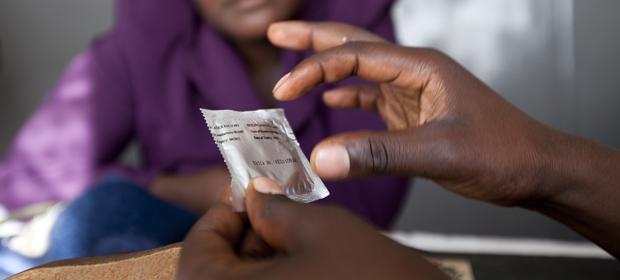Where We Work
See our interactive map


Claver Kamali is a 52-year-old man living with HIV. He lives in a small village nestled in Rwanda’s hilly landscape with his wife and four children. Every month, Claver walks from his village to the nearest health center in Mukono to get his antiretroviral therapy (ART). While he’s there, the health provider tells him about different family planning methods, for example, vasectomy for men, birth control pills for women, and condoms for both.
Claver is among hundreds of patients at Mukono Health Center. Some are HIV-positive like Claver, but others are negative. All are benefitting from the integration of family planning and HIV services at the center. This means that clients seeking HIV services—counseling, testing, and treatment—are also offered family planning methods. It also means all clients looking for family planning services are offered HIV counseling and testing.
This one-stop-shop approach to family planning and HIV care allows clients to get both services at the same time, in the same room with one provider. Before 2008, when the center started the one-stop approach, clients had to go to different areas of the health center for each service, which meant they waited longer, and the clinic was less efficient. Clients also feel that integrated services have helped protect confidentiality.
“Now that services are integrated, it’s difficult to know who has HIV and who doesn’t because there’s one waiting room for everyone,” Claver says.
The link between HIV care and family planning is also critical. Clients seeking family planning services may engage in unprotected sex and put themselves at risk for HIV infection, particularly if they are in a serodiscordant relationship. Conversely, family planning is especially important for HIV-positive parents to lower the risk of transmission to their infant and to ensure an HIV-positive woman is healthy enough to carry a pregnancy. Francoise Mukabarebe, an HIV-positive woman in her first trimester, says, “Before becoming pregnant, I talked about the possibility with a health provider.” Francoise continues to explain that the provider in charge of ART at the health center, Déo Uwigitije, provided counseling to help Francoise and her partner make an informed decision. Following the consultation, Francoise made sure her CD4 count—a measure of the strength of the immune system—was above 500 before getting pregnant. Francoise will also receive triple ART throughout her pregnancy and up to 18 months after delivery to lower the risk of transmitting HIV to her unborn child.
Since integrating family planning and HIV services at the health center, the health worker Déo also says the number of unplanned pregnancies among HIV-positive women is decreasing.
“Before family planning and HIV service integration, an average of ten HIV-positive women per year were having unplanned pregnancies,” Déo says. “Now [from January to September 2011] we only have three HIV-positive clients who became pregnant unintentionally.”
But it’s not just HIV-positive clients who are benefitting from service integration. Since 2008, the year when integration was introduced, the number of clients being counseled and tested for HIV has increased by 61%.
And more clients—both HIV-positive and negative—report they are using contraceptives. Today, 52% of clients of reproductive age are using contraceptives, either modern or natural methods, as compared to 17% before integration.
Déo and his colleague, Vestine Mukabarere, attribute this increase in the use of family planning to service integration, as well as to community outreach—every Monday, health providers visit the community to talk to people about family planning and HIV. On Tuesdays, the program offers mobile services including HIV testing in the community.
Service integration benefits the community and clients and is also changing health providers’ interactions.
“Integration has brought a team spirit to our health center,” Vestine says. “We’re no longer working individually by sending clients to colleagues who specialize in family planning or HIV. Today all nine health providers at our center are trained in family planning methods, and we all understand the importance of encouraging our clients to get tested for HIV.”
In the near future, Déo and Vestine hope that family planning and HIV service integration will result in zero unplanned pregnancies among HIV-positive women, and 100% use of family planning methods among clients of reproductive age who require this service.



